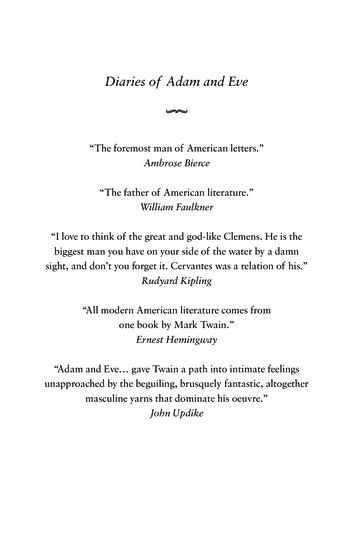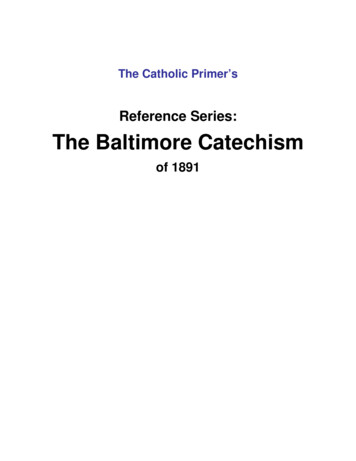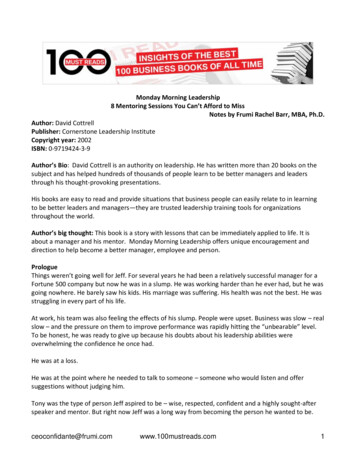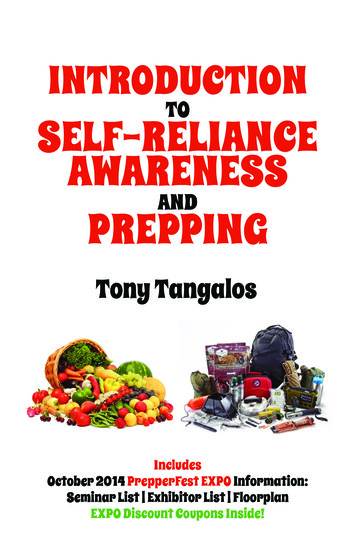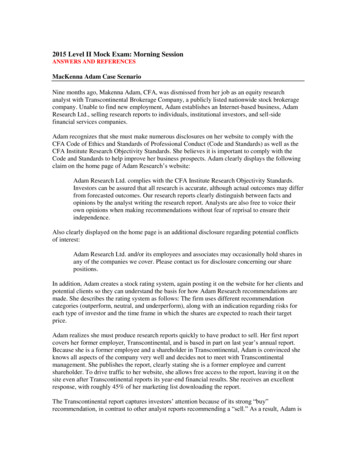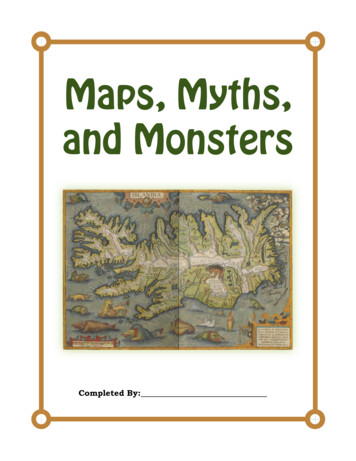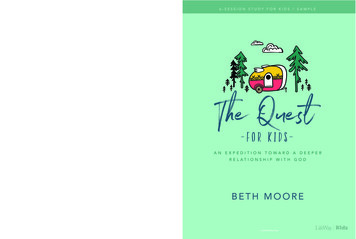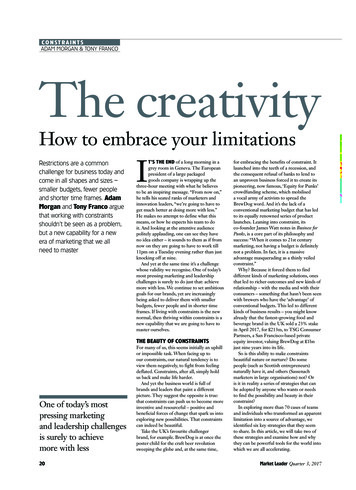
Transcription
co n st ra i n tsAdam Morgan & Tony FrancoThe creativity oHow to embrace your limitationsRestrictions are a commonchallenge for business today andcome in all shapes and sizes –smaller budgets, fewer peopleand shorter time frames. AdamMorgan and Tony Franco arguethat working with constraintsshouldn’t be seen as a problem,but a new capability for a newera of marketing that we allneed to masterIt’s the end of a long morning in agrey room in Geneva. The Europeanpresident of a large packagedgoods company is wrapping up thethree-hour meeting with what he believesto be an inspiring message. “From now on,”he tells his seated ranks of marketers andinnovation leaders, “we’re going to have toget much better at doing more with less.”He makes no attempt to define what thismeans, or how he expects his team to doit. And looking at the attentive audiencepolitely applauding, one can see they haveno idea either – it sounds to them as if fromnow on they are going to have to work till11pm on a Tuesday evening rather than justknocking off at nine.And yet at the same time it’s a challengewhose validity we recognise. One of today’smost pressing marketing and leadershipchallenges is surely to do just that: achievemore with less. We continue to set ambitiousgoals for our brands, yet are increasinglybeing asked to deliver them with smallerbudgets, fewer people and in shorter timeframes. If living with constraints is the newnormal, then thriving within constraints is anew capability that we are going to have tomaster ourselves.The beauty of constraintsOne of today’s mostpressing marketingand leadership challengesis surely to achievemore with less20020-025 Cover Morgan.indd 24For many of us, this seems initially an uphillor impossible task. When facing up toour constraints, our natural tendency is toview them negatively, to fight from feelingdeflated. Constraints, after all, simply holdus back and make life harder.And yet the business world is full ofbrands and leaders that paint a differentpicture. They suggest the opposite is true:that constraints can push us to become moreinventive and resourceful – positive andbeneficial forces of change that spark us intoexploring new possibilities. That constraintscan indeed be beautiful.Take the UK’s favourite challengerbrand, for example. BrewDog is at once theposter child for the craft beer revolutionsweeping the globe and, at the same time,for embracing the benefits of constraint. Itlaunched into the teeth of a recession, andthe consequent refusal of banks to lend toan unproven business forced it to create itspioneering, now famous, ‘Equity for Punks’crowdfunding scheme, which mobiliseda vocal army of activists to spread theBrewDog word. And it’s the lack of aconventional marketing budget that has ledto its equally renowned series of productlaunches. Leaning into constraint, itsco-founder James Watt notes in Business forPunks, is a core part of its philosophy andsuccess: “When it comes to 21st centurymarketing, not having a budget is definitelynot a problem. In fact, it is a massiveadvantage masquerading as a thinly veiledconstraint.”Why? Because it forced them to finddifferent kinds of marketing solutions, onesthat led to richer outcomes and new kinds ofrelationship – with the media and with theirconsumers – something that hasn’t been seenwith brewers who have the ‘advantage’ ofconventional budgets. This led to differentkinds of business results – you might knowalready that the fastest-growing food andbeverage brand in the UK sold a 23% stakein April 2017, for 213m, to TSG ConsumerPartners, a San Francisco-based privateequity investor, valuing BrewDog at 1bnjust nine years into its life.So is this ability to make constraintsbeautiful nature or nurture? Do somepeople (such as Scottish entrepreneurs)naturally have it, and others (Sassenachmarketers in large organisations) not? Oris it in reality a series of strategies that canbe adopted by anyone who wants or needsto find the possibility and beauty in theirconstraint?In exploring more than 70 cases of teamsand individuals who transformed an apparentlimitation into a source of advantage, weidentified six key strategies that they seemto share. In this article, we will take two ofthese strategies and examine how and whythey can be powerful tools for the world intowhich we are all accelerating.Market Leader Quarter 3, 201706/06/2017 13:55
co n st ra i n tsAdam Morgan & Tony FrancoChanging our Mindset aroundConstraints: Are We a Victim,Neutraliser or Transformer?At the centre of making a constraint beautifulis the dynamic tension between our ambitionand the constraint. If we inherently believethat a constraint must limit our ability todeliver our ambition, we will fail to exploreany strategic approach that would allow it tostimulate new possibilities. Indeed, it is usefulto step back right at the beginning, as wefirst face the constraint, and assess what ourMarket Leader Quarter 3, 2017020-025 Cover Morgan.indd 25personal, company or team’s characteristicmindset to this kind of situation is.It may be that we characteristically feelvictims to it. When confronted with a cutin our budget or a tight deadline, the initialand understandable reaction is to push back,to feel helpless and dejected, to rail againstthe unfairness of it all. This is the ‘victimmindset’. Clearly, if we give in to the victimmindset, we give in to the constraint and theonly option is to scale back our ambition –and, frankly, we should probably considerleaving the world of business altogether. Itisn’t going to get any easier from here.If we refuse to let the victim mindsetwin, and start to rethink the situation, thenover time we tend to begin to see possibleways forward and become more positive.We start to seek ways around the constraintwithout lowering our targets – looking forworkarounds or shortcuts. We call this the‘neutraliser mindset’. The solutions are notalways long term, but they help us solve theshort-term issue.tof constraints2106/06/2017 13:55
co n st ra i n tsAdam Morgan & Tony Francocase study: yarm HOW Embracing constraints stimulatedtwo endangered species to build a prosperous new ecosystemJoining forces: Yarm Libraryand Newcastle Building SocietyAs the world moves increasingly online, there are some predictablecasualties fighting for survival. In two of these – building societybranches and public libraries – we can see an example of embracingconstraints to thrive through partnership, a model that one can see willbe an important example for others in the future.But let’s start with the survival instinct. Andrew Haigh, CEO ofNewcastle Building Society, sees branches as essential but an‘endangered species’, needing to adapt in order to survive. So when theidea of creating a new branch within a community-based library inYarm, North Yorkshire, which itself was under threat of closure, wassuggested, it seemed to him like an ideal partnership.The Newcastle Building Society branch in Yarm had closed some yearsbefore, but Haigh felt that this could offer a way to return their branchservice to the town, and benefit the community by helping keep thelibrary open at the same time: shared space could solve both of theircommercial constraints. So in October 2016, Newcastle Building Societyopened the UK’s first branch within an existing public library in Yarm.Embracing the constraints of space, noise, resource and function in ashared, more limited space such as this posed an obvious challenge.22020-025 Cover Morgan.indd 26How do you fit standard branch operations into a space only 20% thesize of a normal branch? They could if they removed superfluouselements and scaled everything back to bare essentials. The Yarmbranch has just one private meeting room, one till position and a secureback office, yet it could still operate just like a traditional branch.Greater emphasis on electronic transactions over paper ones wasintroduced, as well as booking appointments that fit in with theschedule of the library – avoiding 10am, for example, when a motherand-toddler group meets every morning. With no formal waiting area,customers are encouraged to use the library or garden to wait in, andthe limited staff from both sides help each other out, whether queriesconcern books or finances.While this might have started as an encouraging story about twoworthy groups partnering to survive, the real impact of the partnershiphas been much more interesting than that. Since the branch opened,the number of library visitors in Yarm has grown by 43% and booklendings increased by 12%. Newcastle Building Society has found thatnew customer sign-ups in Yarm are 39% higher than its branchaverage, with customer appointments 25% above the norm.Market Leader Quarter 3, 201706/06/2017 13:55
co n st ra i n tsAdam Morgan & Tony FrancoStrategy 1:Make your constraint anexplicit and integral partof a stretch ambitionWe tend to separate the statement of ourambition from the practical constraints todelivering it. In fact, we have become used toso-called ‘blue-sky’ brainstorms, where theleader tells us to ‘take the constraints out ofthe room, and imagine we could do anythingwe wanted’.Our first step is to do the opposite of this:take a bold ambition and link it explicitlyto the specific and real constraint we facein delivering it. Re-express your primarychallenge in the form of a question thatgives you real focus and energy. By puttingthe constraint at the very heart of our corestrategic question, we ensure the solutionmust make use of the constraint, not justwork around it. We call this kind of questiona ‘propelling question’, because it propelsyou out of the ways you have been thinkingabout the problem and away from the placesin which you have been looking for solutionsup to now.This then is the antidote to blue-skythinking: black-sky thinking, if you like.Trying to answer our propelling questioninitially creates a tension and a sense ofdiscomfort – we can’t simply rely on theobvious, well-worn path we have followedup to now, no matter how successful it hasproved in the past. This mental discomfortMarket Leader Quarter 3, 2017020-025 Cover Morgan.indd 27is essential to fertile creative exploration,because it forces us to re-examine ourunderlying assumptions and experimentwith new ideas that push us away from theusual solutions to which we have becomeaccustomed.IKEA is a business that needs to set itselfimpossible challenges in order to achieveits ambition to deliver ‘a better life for themany’, a democratiser of good design for thehome; leaning into constraint – around pricepoint, around space, around sustainability– is baked into everything they do. One ofits most popular products, the Lack coffeetable, was the result of one such (apparentlyimpossible) question, namely: ‘How can wecreate a well-designed, durable table thatcould be made for less than 5 and sold at aprofit?’Imposing a price point so far beyond whatthey had designed before meant that thedesign team were not able to adapt previousapproaches: they needed to completelyrethink how this could be done. Typically,similar coffee tables were sold for at leasttwice this price and often much higher.It pushed them beyond historical designsolutions into working in new ways withother departments and partners, includinglooking at entirely new manufacturingmethods. It’s an approach that IKEA hasbecome accustomed to. Indeed, its inventionof flat-packed furniture in the 1950s wasdriven by a desire to create practical, costeffective furniture for the home, somethingit called ‘democratic design’. Its explorationled IKEA to doors, finding that while it wasrelatively costly to produce a solid woodtable, it was much more cost-efficient tomake a door from a type of honeycombboard. Thinking of their new table as ‘half adoor’ saved on both production and shippingcosts, enabling IKEA to halve its retailprice – a price point competitors have yet tomatch.How to create your ownPropelling QuestionTranslating a broader challenge into apropelling question requires disciplineand precision. First, you need to be clearon the nature of your ambition. Typically,this tends to fall into the following groups:the ambitions of driving growth (sales andprofit); creating impact; a great customerexperience; delivering a new level of qualityor achieving superiority.Similarly, constraints can come indifferent forms: a limited supply offinancial, human or physical resource; a lackof time; an absence of something regardedas a necessary ‘foundation’ for your businesstTake a bold ambitionand link it explicitlyto the real constraint.This is the antidoteto blue-sky thinking:black-sky thinkingWhat is more interesting is beginningwith a mindset such as Watt’s – that anyconstraint is pregnant with opportunity. Bythen using our constraint as a springboardfor a new way to think about deliveringour ambition, we find it can be possible tonot only achieve but increase and surpassour original goal. One could call thisthe ‘transformer mindset’. It is here thatindividuals, teams or organisations stepback, rethink the nature of the problemand where to find solutions to it, and areable to apply a series of strategies to findentirely new kinds of beneficial ecosystems,partnerships and ideas.And while we may think that this is naturenot nurture – that we all fall into just one ofthese boxes, where some of us are blessedwith natural creativity and resourcefulness,while others are stuck as victims or, at best,neutralisers – our research suggests theopposite to be true. We can all adopt thetransformer mindset if we are given ‘justenough strategy’ to start to understand howto look for solutions.So here are two strategies to take intoyour planning this year.2306/06/2017 13:55
co n st ra i n tsAdam Morgan & Tony Franco(a salesforce, for example); or the constraintof method (having to do something in acertain way).Strategy 2:Creating the right culture offinding solutions toyour Propelling QuestionSo how do you go about answering yourpropelling question? Colin Kelly, globalquality director at William Grant and Sons,talks of the power of making a team alwaysstart an answer with the phrase ‘We canif ’, rather than ‘We can’t because ’.The first keeps all the energy and focus ofthe group on the right question (‘How canwe solve this problem, even if we need toapproach it in a different way from usual?’),whereas the second allows it to drift into adifferent one (‘Is this a problem that can besolved?’).Inspired by his insight, we workedthrough the cases we researched to identifya number of different ‘can-if’ solutiontypes. From grouping the most common,we developed the ‘Can-If map’ – a practicaltool to give teams a stimulating jumping-offpoint to help answer their own propellingquestion. For ease of navigation, we willreduce the fuller map to just six types here.Let’s explore a couple of these points We Can If we remove or substituteThis is about substituting one apparentlyessential part of the product, process orexperience with something different orelse removing it entirely. The PropellingQuestion set by hotel chain citizenM was‘How can we create a contemporary, luxuryexperience at an affordable price?’ WeCan if we remove all the stuff you findin hotels but don’t need – minibars, paperreceipts, robes and slippers – and substitutethem with what the modern businesstraveller really needs, such as free Wi-Fi,in-room technology, crisp bed linen and coollounges.We Can If we access other peopleThis approach uses the skills, expertiseand willingness of other people you don’tnormally turn to. The propelling questionfaced by the drought-plagued state ofCalifornia was ‘How can we recruit another4,000 firefighters to combat forest fires (anextremely dangerous job) when we can onlyafford to pay people 2 a day?’ The solutionwas to access inmates of the federal prisonsystem. As well as earning a higher wagethan the other work programmes available,the inmates speak of learning new skills anda feeling of purpose from their involvement24020-025 Cover Morgan.indd 28Get your team together: Use the following five steps1 Identify an important challenge that you are facing and capture this in broad terms.2 Brainstorm potential bold ambitions based on your challenge: growth; quality; superiority;experience; impact. Once you have chosen an ambition, push it further – do you want togrow your business by a factor of two? Why not x10 or x20?3 Identify and capture the most significant constraints that are currently preventing you fromachieving your ambitions: a lack of time; money; or resources? Again, push it even further. Doyou need to launch a new product in six months? How could you do it in three?4 Develop a number of candidate propelling questions that see your ambitions andconstraints collide, such as: How can we . . (insert bold ambition) without/while .(insert significant constraint).5 Mix and match until you reach a combination that gets your attention – what question canyou ask that would make the team a little nervous but really stimulated about the challenge?Pick the one that creates a spark.We thinkof it as We remove orsubstitute We mixtogether WeCan IfWe introducea new We access otherpeople to We resourceor fund it by in the scheme. As one inmate firefightertold the BBC: “From being locked up, youcan’t beat this experience. I’ve got to flyin helicopters. I’ve learned the trades ofrunning a saw, ‘cutting a line’. I’ve been inand out of prison for five years, but this isthe first time I actually want to live the rightway when I get out.”We Can If we introduce a new This type of Can-If centres on introducinga new product or service dimension into theprocess. In their early days, Warby Parker,the American online eyewear retailer, neededMarket Leader Quarter 3, 201706/06/2017 13:55
co n st ra i n tsAdam Morgan & Tony FrancoWhen California needed to recruit 4,000 firefighters but could only pay them 2 a day, it found willing volunteers in the federal prison systemto address the problem of not having bricksand-mortar stores – ‘How can we increaseour sales of glasses to design-consciousbuyers when they can’t try them on in-storebefore they buy?’ The answer was tointroduce a home trial service – try five pairsfor free at home without any obligationto buy – a much-copied innovation thatdelivered consumer need but also becamean unexpected social media campaign too, astriallists invited their friends on Facebook totell them which frame they looked best in.depth and specificity. Develop these intomore finished concepts, early prototypes.4 SelectUse selection criteria to identify thoseconcepts that best address the propellingquestion.Reclaiming inventivenessHow to use the Can-If MapSince the rebirth of Apple and the arrival ofa new generation of tech wonder-products,the business world has been in thrall toinnovation; Amazon offers more than 70,000titles on the subject alone. Cross-bred withdisruption, innovation has become the stuff1 PlacePrint out a large version of the Can-If Mapand place your propelling question in thecentre.2 GenerateFirst, individually move around the Can-IfMap, generating ideas for each launch padthat spontaneously occur to you. Second, asa team, revisit the map and work each of thespokes harder still, generating further ideas.3 PushStep back and review the ideas generated.Spot and select those that you feel havethe most potential. Combine ideas whereappropriate to make them bigger andbetter. Working in pairs, take the selectedideas and sharpen them, adding moreMaking our constraintsbeautiful – as businesses,as people – demands adifferent kind ofcreativity: inventivenessMarket Leader Quarter 3, 2017020-025 Cover Morgan.indd 29of sealed labs and super-geeks, brilliantpeople in a box on the edge of our businesscampus who are going to come up with theproduct or service that is going to transformthe future of a company. My god, they’reclever, we say to ourselves; let’s leave thetransformative stuff to them.But making our constraints beautiful – asbusinesses, as people – demands a differentkind of creativity: inventiveness. It’s notconfined to a few brilliant people, but is theprovince and potential capability of us all.And as many of these examples show, it’s acomplementary capability that has the abilityto change the trajectory of our businessas significantly as all those ideas in theinnovation pipeline.But first we need to give this kind ofinventiveness a name, attach some keystrategies to it and make it a replicablecapability. One that has the power to makeall our constraints beautiful.Adam Morgan is founder of eatbigfish andco-author of A Beautiful Constraint.adam@eatbigfish.comTony Franco is an associate partner of theABConstraint Company, in partnershipwith 7 13:55
At the centre of making a constraint beautiful is the dynamic tension between our ambition and the constraint. If we inherently believe that a constraint must limit our ability to deliver our ambition, we will fail to explore any strategic approach that would allow it to stimulate new possibilities. Indeed, it is useful

